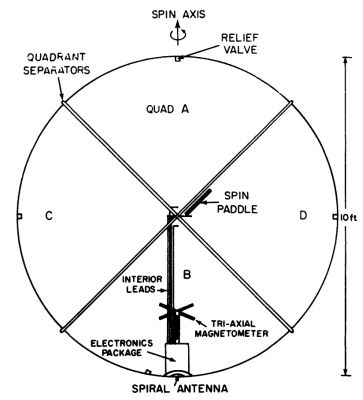Purpose of the flight and payload description
The Balloon Electric Field Sensor, or BEFS, was designed to measure a full profile of the vector electric field, from the ground through the top of a cloud. It consisted of a superpressure spherical balloon, with a conductive metal coating on the outer surface, and the associated electronics package which was mounted inside the balloon. The metallized surface of the balloon was divided into four conducting regions that were electrically isolated from one another on the balloon surface (see figure at left). Two of these lunal regions were symmetric about the vertical spin axis while the other two were symmetric about the horizontal axis. These conducting quadrants served as the sensing elements of the instrument: when the balloon was exposed to an electric field, charge was induced on these conducting surfaces. As the balloon changed its orientation with respect to this field, the induced surface charge was redistributed. A resulting induction current was measured as it passed through the wires connecting each symmetric lunar pair with electrometer circuits. Since the orientation of the balloon could be determined from on-board sensors, this induction current could be used to calculate the external vector electric field.
The balloon, manufactured by Schjeldahl using mylar, was ten feet in diameter, and displaced 524 cubic feet, allowing a five pound payload to be taken to 32,000 feet. A total of four relief valves were mounted on the balloon. These were necessary in order to allow for sufficient out-gassing during flight. The valves were set to maintain a positive pressure differential of 40 millibars inside the balloon. The measured currents as well as housekeeping data from a pressure sensor, magnetometers, and thermistors were fed to a multiplexer, sampled, and then fed through a sample/hold amplifier to a twelve bit analog-to-digital converter. The digitized data was sent to the ground using a 1680 khz transmitter and a surface mounted, cavity backed, spiral antenna.
The magnetometers were used for the determination of the balloon orientation. The pressure gauge measured the atmospheric pressure inside the thunderstorm or, if radar tracking failed, served as an altitude indicator. The external thermometer measured the temperature profile of the thunderstorm, while the internal thermometer supplied housekeeping information. Because of its metallic coating, the balloon was easily tracked by radar or using a standard meteorological rawinsonde receiver. Thus, not only could the BEFS experiment measure the vector electric field within a thunderstorm, but it could also supply information on the storm's temperature, pressure, and wind structure.
Details of the balloon flight
Balloon launched on: 5/17/1974 at 16:29 cdt
Launch site: Columbia Scientific Balloon Facility, Palestine, Texas, US
Balloon launched by: National Scientific Balloon Facility (NSBF)
Balloon manufacturer/size/composition: Zero Pressure Balloon Schjeldahl - 3048 m3 (Mylar scrim)
Flight identification number: 827P
End of flight (L for landing time, W for last contact, otherwise termination time): 5/17/1974 at 18:04 cdt
Balloon flight duration (F: time at float only, otherwise total flight time in d:days / h:hours or m:minutes - ): 1 h 35 m
Payload weight: 2.3 kgs
This flight was originally planned to enter a thunderstorm, but the Federal Aviation Agency of the United States claimed that while inside a thunderstorm, the BEFS could be hazardous to aircraft. After months of negotiation, the FAA only allowed a fair weather flight.
The test took place at 16:29 CDT on 17 May 1974, from the NCAR Balloon Facility near Palestine, Texas. At the time of launch, there were scattered cumulus clouds in the vicinity of Palestine, but radar indicated no thunderstorm activity in the area. The balloon reached a maximm altitude of 8.3 km approximately forty minutes after launch. The total flight duration was 1 hour and 35 minutes. The low float altitude resulted from the weight imposed by the positive recovery system (a FAA requirement) and from the fact that a certain amount of air was introduced into the balloon prior to launch.
A subsequent flight of the detector into a thunderstorm was performed in August 16, 1975 from the Langmuir Laboratory in New Mexico.
External references
- Design and Evaluation of a Balloon-Borne Electric Field Sensor available at DTIC
- National Scientific Balloon Facility Annual Report FY 1974 National Center for Atmospheric Research, December 1974
5332If you consider this website interesting or useful, you can help me to keep it up and running with a small donation to cover the operational costs. Just the equivalent of the price of a cup of coffee helps a lot.


